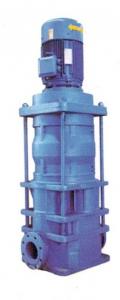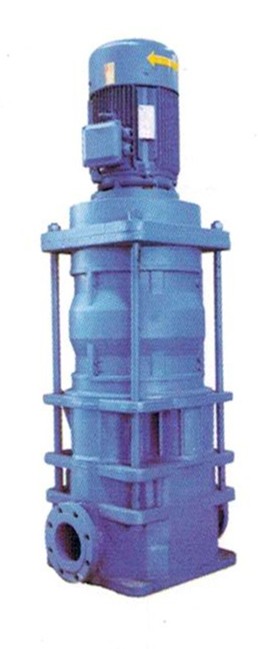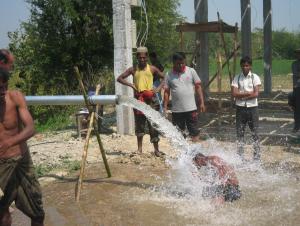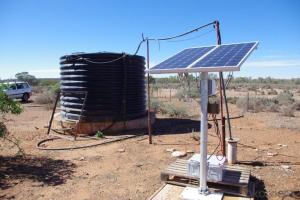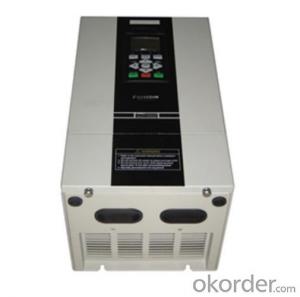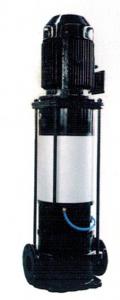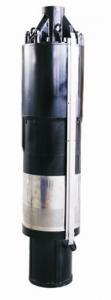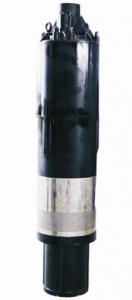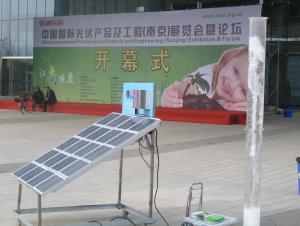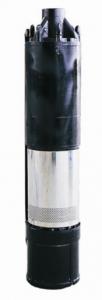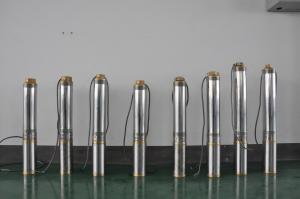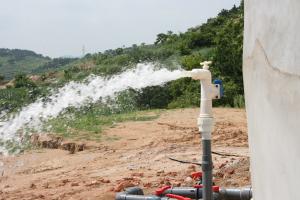Pumplus Solar Pump L3D-24-300 Solar Water Pump
- Loading Port:
- China Main Port
- Payment Terms:
- TT OR LC
- Min Order Qty:
- -
- Supply Capability:
- 300 sets set/month
OKorder Service Pledge
OKorder Financial Service
You Might Also Like
Product description:
Product: Solar water pump
Model:L3D-24-300
Appilication:
surface pump
for surface water of pond, river, lake
for irrigation of a big farm with 15000 m2 on the top of a high mountain
Product specification:
flow rate:24m3/ hour, 300m3/day.
lift: 10m-300m
pump diameter: 610mm
Pump installed on the ground, outlet to the water surface:4m
with AC motor, motor power:22kW
but only need solar power:24kW(while Grundfos pump needs at least 45kW solar power, our pump can save more than 50% solar panel power,save USD15000 cost for solar panel per set.
Material:
Pump inside: stainless steel and wearable nylon,it enables our solar pump to have 10 years sevice life.
Motor : AC motor, 380V , three phase , 50Hz. The pump also can connect with grid power directly.
Certification:
3 International patent
ISO9001
CE
Warranty:2 years
- Q: Can a solar pump be used in areas with high dust or sand particles in the air?
- Yes, a solar pump can be used in areas with high dust or sand particles in the air. However, it is important to regularly clean the solar panels to ensure their efficiency and performance. Additionally, using a filtration system or installing a sediment filter can help prevent damage to the pump due to the presence of dust or sand particles in the water.
- Q: Can a solar pump be used for fountain installations?
- Indeed, fountain installations can utilize solar pumps. These pumps are specially designed to operate efficiently and harness solar power, rendering them an eco-friendly alternative for fountains. Their functioning involves the conversion of sunlight into electricity, which in turn propels the pump to circulate water within the fountain. Installing solar pumps tends to be straightforward, and they necessitate minimal upkeep. Furthermore, these pumps are suitable for both small and large fountain installations. Moreover, they do not mandate a direct electrical connection, thereby eliminating the need for wiring or reliance on grid electricity. On the whole, utilizing a solar pump presents an excellent opportunity to power fountain installations with renewable energy.
- Q: Can a solar pump be used in areas with high levels of arsenic in the water?
- Yes, a solar pump can be used in areas with high levels of arsenic in the water. Solar pumps are primarily used to extract and deliver water from various sources, such as wells, rivers, or lakes, using solar energy. Although they do not directly address the issue of arsenic contamination, solar pumps can be integrated into water treatment systems to help mitigate the presence of arsenic. By combining a solar pump with appropriate filtration and purification techniques, it is possible to remove or reduce the arsenic content in the water, making it safe for consumption or other purposes. However, the effectiveness of this approach may vary depending on the specific water quality and level of arsenic contamination in a given area.
- Q: How does a solar pump handle water with high levels of acidity or alkalinity?
- A solar pump is typically not designed to handle water with high levels of acidity or alkalinity. Water with extreme pH levels can damage the components of the pump, such as the motor, wiring, or pump housing. To handle water with high acidity or alkalinity, it is recommended to use additional equipment like filters, pH neutralizers, or pre-treatment systems to adjust the water's pH level before it reaches the solar pump. These precautions help protect the pump and ensure its optimal functionality.
- Q: Can a solar pump be used in areas with high air pollution levels?
- Yes, a solar pump can be used in areas with high air pollution levels. Solar pumps rely on sunlight to generate electricity, and they are not affected by air pollution as long as sunlight can reach the solar panels. However, it is important to regularly clean the solar panels to ensure maximum efficiency, as air pollution can accumulate on the panels and reduce their effectiveness. Additionally, it is recommended to use high-quality solar panels with anti-reflective coatings to minimize the impact of air pollution on the system's performance. Overall, while air pollution may have some indirect effects on the maintenance and efficiency of a solar pump, it does not prevent its usage in areas with high pollution levels.
- Q: How does the efficiency of a solar pump compare to a traditional electric pump?
- The efficiency of a solar pump is generally higher compared to a traditional electric pump. Solar pumps are designed to convert solar energy into mechanical energy, eliminating the need for grid electricity. They utilize sunlight, which is a renewable and abundant energy source, to power the pump. Traditional electric pumps, on the other hand, rely on fossil fuel-generated electricity from the grid, which can be subject to price fluctuations and availability issues. Solar pumps have lower operational costs and a longer lifespan, making them more cost-effective in the long run. Additionally, solar pumps have a smaller carbon footprint, as they do not produce greenhouse gas emissions during operation. Overall, the efficiency of a solar pump surpasses that of a traditional electric pump in terms of energy consumption, environmental impact, and cost-effectiveness.
- Q: Are there any limitations to using a solar pump?
- Yes, there are certain limitations to using a solar pump. One major limitation is that solar pumps are dependent on sunlight for their operation. This means that they may not be as effective or efficient during cloudy or rainy days, or in areas with limited sunlight. The amount of power generated by the solar panels directly affects the pump's performance, so if there is not enough sunlight, the pump may not be able to function optimally. Another limitation is the initial cost of installing a solar pump system. While solar pumps can save money in the long run by reducing electricity bills, the upfront costs can be significant. The cost includes not only the pump but also the solar panels, batteries, and other necessary components. This may make it less accessible for individuals or communities with limited financial resources. Additionally, solar pumps require adequate space for the installation of solar panels. The panels need to be positioned in a way that maximizes exposure to sunlight, which may require a large open area or a rooftop with unobstructed access to sunlight. In some urban or densely populated areas, finding suitable space for solar panels can be a challenge. Maintenance and repair can also be a limitation. Solar pumps require regular maintenance to ensure their efficient operation. This includes cleaning the solar panels, checking connections, and inspecting other components. If a part malfunctions or breaks, it may be more challenging to find specialized technicians or spare parts compared to conventional pumps. Lastly, the capacity of solar pumps can be limited. They may not be suitable for high-demand applications that require significant water flow or pressure. Larger-scale agricultural or industrial operations may require more powerful pumps that solar energy alone may not be able to provide. Despite these limitations, solar pumps offer numerous advantages such as energy efficiency, environmental friendliness, and long-term cost savings. It is important to carefully assess the specific requirements and limitations of your situation before deciding to use a solar pump.
- Q: What is the expected lifespan of the controller used in a solar pump system?
- The expected lifespan of a controller used in a solar pump system can vary depending on various factors such as the quality of the controller, the brand, and the environmental conditions it is exposed to. Generally, a well-made and properly maintained controller can last anywhere from 5 to 15 years or even longer. High-quality controllers designed specifically for solar pump systems are usually built to withstand harsh weather conditions, such as extreme temperatures, humidity, and dust. They are also equipped with protective features like surge protection and overvoltage protection to safeguard against electrical fluctuations and power surges. Regular maintenance and periodic inspections can extend the lifespan of the controller. This includes cleaning the controller to remove dust and debris, checking for loose connections, and ensuring proper ventilation to prevent overheating. It's worth noting that some manufacturers offer warranties for their controllers, which can provide additional peace of mind regarding their expected lifespan. Therefore, it is important to consider factors such as the controller's quality, brand reputation, environmental conditions, and maintenance practices when estimating the expected lifespan of a controller used in a solar pump system.
- Q: Are there any government incentives or subsidies for using solar pumps?
- Yes, many governments around the world offer incentives and subsidies for using solar pumps. These incentives aim to promote the adoption of renewable energy sources, reduce dependence on traditional power sources, and stimulate the growth of the solar pump industry. These incentives can include tax credits, grants, subsidies for equipment installation and maintenance, and favorable financing options.
- Q: What is the minimum solar power requirement for a solar pump?
- The minimum solar power requirement for a solar pump depends on various factors such as the desired flow rate, water lift, and the efficiency of the pump. However, on average, a small solar pump for household use typically requires a minimum solar power output of around 200 to 400 watts.
Send your message to us
Pumplus Solar Pump L3D-24-300 Solar Water Pump
- Loading Port:
- China Main Port
- Payment Terms:
- TT OR LC
- Min Order Qty:
- -
- Supply Capability:
- 300 sets set/month
OKorder Service Pledge
OKorder Financial Service
Similar products
Hot products
Hot Searches
Related keywords
